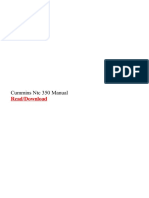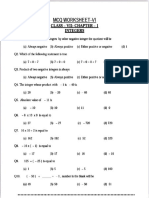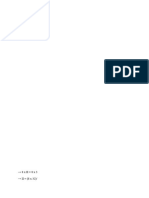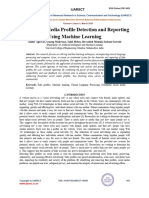0 ratings0% found this document useful (0 votes)
79 viewsLinear Equations in Two Variables
The document contains 11 questions about linear equations and their solutions. Each question presents an assertion and a reason, and asks which of the following choices is correct: a) assertion and reason are true and the reason explains the assertion, b) assertion and reason are true but the reason does not explain the assertion, c) assertion is true but reason is false, or d) assertion is false but reason is true. The document then provides the reasoning and answers for each question.
Uploaded by
Vedyam AcademyCopyright
© © All Rights Reserved
Available Formats
Download as PDF, TXT or read online on Scribd
0 ratings0% found this document useful (0 votes)
79 viewsLinear Equations in Two Variables
The document contains 11 questions about linear equations and their solutions. Each question presents an assertion and a reason, and asks which of the following choices is correct: a) assertion and reason are true and the reason explains the assertion, b) assertion and reason are true but the reason does not explain the assertion, c) assertion is true but reason is false, or d) assertion is false but reason is true. The document then provides the reasoning and answers for each question.
Uploaded by
Vedyam AcademyCopyright
© © All Rights Reserved
Available Formats
Download as PDF, TXT or read online on Scribd
You are on page 1/ 12
ASSERTION & REASONING QUESTIONS
DIRECTION : In the following questions, a statement of assertion (A) is followed by a
statement of reason (R). Mark the correct choice as:
(a)Both assertion (A) and reason (R) are true and reason (R) is the correct explanation
of assertion (A).
(b)Both assertion (A) and reason (R) are true but reason (R) is not the correct
explanation of assertion (A).
(c)Assertion (A) is true but reason (R) is false.
(d)Assertion (A) is false but reason (R) is true.
1. Assertion : A linear equation 3x + 5y = 2 has a unique solution.
Reason : A linear equation in two variables has infinitely many solutions.
(a)Both assertion (A) and reason (R) are true and reason (R) is the correct explanation
of assertion (A).
(b)Both assertion (A) and reason (R) are true but reason (R) is not the correct
explanation of assertion (A).
(c)Assertion (A) is true but reason (R) is false.
(d)Assertion (A) is false but reason (R) is true.
Ans: We know that a linear equation in two variables has infinitely many
solutions.
So, Reason is correct.
Hence, Assertion is not correct
Correct option is (d) Assertion (A) is false but reason (R) is true.
2. Assertion : If x = 2, y = 1 is a solution of the equation 2x + 3y = k, then the value
of k is 7.
Reason : The solution of the line will satisfy the equation of the line.
(a)Both assertion (A) and reason (R) are true and reason (R) is the correct explanation
of assertion (A).
(b)Both assertion (A) and reason (R) are true but reason (R) is not the correct
explanation of assertion (A).
(c)Assertion (A) is true but reason (R) is false.
(d)Assertion (A) is false but reason (R) is true.
Ans: We know that the solution of the line will satisfy the equation of the line.
So, Reason is correct.
Since x = 2, y =1 is a solution of the given linear equation, we have
2 x 2 + 3 x 1 – k = 0 ⇒ 4 + 3 – k = 0 ⇒ k =7.
So, Assertion is also correct
Correct option is (a) Both assertion (A) and reason (R) are true and reason (R)
is the correct explanation of assertion (A).
3. Assertion : If x = 2k – 1 and y = k is a solution of the equation 3x – 5y – 7 = 0,
then the value of k is 10
Reason : A linear equation in two variables has infinitely many solutions.
(a)Both assertion (A) and reason (R) are true and reason (R) is the correct explanation
of assertion (A).
(b)Both assertion (A) and reason (R) are true but reason (R) is not the correct
explanation of assertion (A).
(c)Assertion (A) is true but reason (R) is false.
(d)Assertion (A) is false but reason (R) is true.
Ans: We know that a linear equation in two variables has infinitely many
solutions. So, Reason is correct.
Since x = 2k - 1 and y = k is solution of the given linear equation, we have
3 x (2k – 1) – 5k – 7 = 0 ⇒ 6k – 3 – 5k – 7 = 0 ⇒ k – 10 = 0 ⇒ k = 10.
So, Assertion is also correct
But reason (R) is not the correct explanation of assertion (A).
Correct option is (b) Both assertion (A) and reason (R) are true and reason (R)
is not the correct explanation of assertion (A).
4. Assertion : There are infinite number of lines which passes through (3, 2).
Reason : A linear equation in two variables has infinitely many solutions.
(a)Both assertion (A) and reason (R) are true and reason (R) is the correct
explanation of assertion (A).
(b)Both assertion (A) and reason (R) are true but reason (R) is not the correct
explanation of assertion (A).
(c)Assertion (A) is true but reason (R) is false.
(d)Assertion (A) is false but reason (R) is true.
Ans: We know that a linear equation in two variables has infinitely many
solutions. So, Reason is correct.
Through a point infinite lines can be drawn.
Through (3, 2) infinite number of lines can be drawn.
Hence, Assertion is also correct.
But reason (R) is not the correct explanation of assertion (A).
Correct option is (b) Both assertion (A) and reason (R) are true and reason
(R) is not the correct explanation of assertion (A).
5. Assertion: x = 3 and y = 2 is a solution of the linear equation 2x + 3y = 12.
Reason: x = 4 and y = 2 is a solution of the linear equation x + 3y = 10.
Ans: For Assertion: The given linear equation is 2x + 3y = 12
Substituting x = 3 and y = 2, we get
LHS = 2 x 3 + 3 x 2 = 6 + 6 = 12 = RHS
So, Assertion is correct.
For Reason: The given linear equation is x + 3y = 10
Substituting x = 4 and y = 2, we get
LHS = 4 + 3 x 2 = 4 + 6 = 10 = RHS
So, Reason is also correct.
But reason (R) is not the correct explanation of assertion (A).
Correct option is (b) Both assertion (A) and reason (R) are true and reason (R)
is not the correct explanation of assertion (A).
6. Assertion : The point (3, 0) lies on the graph of the linear equation 4x + 3y = 12.
Reason : (3, 0) satisfies the equation 4x + 3y = 12.
(a)Both assertion (A) and reason (R) are true and reason (R) is the correct
explanation of assertion (A).
(b)Both assertion (A) and reason (R) are true but reason (R) is not the correct
explanation of assertion (A).
(c)Assertion (A) is true but reason (R) is false.
(d)Assertion (A) is false but reason (R) is true.
Ans: For Assertion: The given linear equation is 4x + 3y = 12
Substituting x = 3 and y = 0, we get
LHS = 4 x 3 + 3 x 0 = 12 + 0 = 12 = RHS
Since (3, 0) satisfies the equation 4x + 3y = 12, therefore point (3, 0) lies on
the graph of the linear equation 4x + 3y = 12.
So, Reason and Assertion are both correct.
Here, Reason is the correct explanation of Assertion.
Correct option is (a) Both assertion (A) and reason (R) are true and reason (R)
is the correct explanation of assertion (A).
7. Assertion : The graph of the linear equation 2x – y = 1 passes through the point (2, 3).
Reason : Every point lying on graph is not a solution of 2x – y = 1.
(a)Both assertion (A) and reason (R) are true and reason (R) is the correct explanation
of assertion (A).
(b)Both assertion (A) and reason (R) are true but reason (R) is not the correct
explanation of assertion (A).
(c)Assertion (A) is true but reason (R) is false.
(d)Assertion (A) is false but reason (R) is true.
Ans: For Assertion: The given linear equation is 2x – y = 1
Substituting x = 2 and y = 3, we get
LHS = 2 x 2 – 3 = 4 – 3 = 1 = RHS
Since (3, 0) satisfies the equation 4x + 3y = 12, therefore graph of the
linear equation 2x – y = 1 passes through the point (2, 3).
So, Assertion is correct.
But Reason is not correct as every point lying on graph is a solution of
2x – y = 1.
Correct option is (c) Assertion (A) is true but reason (R) is false.
8. Assertion: x = 2 is a line parallel to the y-axis.
Reason: The equation of a line parallel to the y-axis is x = a.
(a)Both assertion (A) and reason (R) are true and reason (R) is the correct explanation
of assertion (A).
(b)Both assertion (A) and reason (R) are true but reason (R) is not the correct
explanation of assertion (A).
(c)Assertion (A) is true but reason (R) is false.
(d)Assertion (A) is false but reason (R) is true.
Ans: We know that equation of a line parallel to the y-axis is x = a.
So, Reason (R) is true.
Also, x = 2 is a line parallel to the y-axis.
So, Assertion (A) is true.
Thus, Reason (R) and Assertion (A) are true and Reason (R) is a correct
explanation of Assertion (A).
Correct option is (a) Both assertion (A) and reason (R) are true and reason
(R) is the correct explanation of assertion (A).
9. Assertion: x + y = 3 is the equation of a line passing through the origin.
Reason: y = 2x is the equation of a line passing through the origin.
(a)Both assertion (A) and reason (R) are true and reason (R) is the correct explanation
of assertion (A).
(b)Both assertion (A) and reason (R) are true but reason (R) is not the correct
explanation of assertion (A).
(c)Assertion (A) is true but reason (R) is false.
(d)Assertion (A) is false but reason (R) is true.
Ans: For Assertion: The given linear equation is x + y = 3
Since x = 0 and y = 0 is not satisfying x + y = 3, therefore it is not passing
through the origin.
So, Assertion is not correct.
Since x = 0 and y = 0 is not satisfying y = 2x, therefore it is passing
through the origin.
So, Reason is correct.
Correct option is (d) Assertion (A) is false but reason (R) is true.
10. Assertion: y = 3x represents a line passing through the origin.
Reason: Any line parallel to the x-axis is y = a.
(a)Both assertion (A) and reason (R) are true and reason (R) is the correct explanation
of assertion (A).
(b)Both assertion (A) and reason (R) are true but reason (R) is not the correct
explanation of assertion (A).
(c)Assertion (A) is true but reason (R) is false.
(d)Assertion (A) is false but reason (R) is true.
Ans: Since x = 0 and y = 0 is not satisfying y = 3x, therefore it is passing
through the origin.
So, Assertion (A) is true.
Also, we know that equation of a line parallel to the x-axis is y = a.
So, Reason (R) is also true.
But Reason is not the correct explanation of Assertion.
Correct option is (b) Both assertion (A) and reason (R) are true and reason
(R) is not the correct explanation of assertion (A).
11. Assertion : The point (2, 2) is the solution of x + y = 4.
Reason : Every point which satisfy the linear equation is a solution of the equation.
Ans: We know every point which satisfy the linear equation is a solution of
the equation.
So, Reason (R) is true.
Substituting x = 2 and y = 2, we get
LHS = 2 + 2 = 4 = RHS
Since (3, 0) satisfies the equation 4x + 3y = 12, therefore the point (2, 2) is
the solution of x + y = 4
So, Assertion (A) is also true.
Here, Reason is the correct explanation of Assertion.
Correct option is (a) Both assertion (A) and reason (R) are true and reason
(R) is the correct explanation of assertion (A).
You might also like
- Agriculture Department Assam General Maths Question & AnswersNo ratings yetAgriculture Department Assam General Maths Question & Answers11 pages
- Assertion Reasoning Questions: DIRECTION: in The Following Questions, A Statement of Assertion (A) Is Followed by ANo ratings yetAssertion Reasoning Questions: DIRECTION: in The Following Questions, A Statement of Assertion (A) Is Followed by A11 pages
- ABC SYDNEY STT Thinking Skills Unit 008 2 QuestionsNo ratings yetABC SYDNEY STT Thinking Skills Unit 008 2 Questions5 pages
- Full Download Shortcuts in Reasoning Verbal Non Verbal Analytical Critical for Competitive Exams 2nd Edition Disha Experts PDF DOCX100% (4)Full Download Shortcuts in Reasoning Verbal Non Verbal Analytical Critical for Competitive Exams 2nd Edition Disha Experts PDF DOCX81 pages
- Syllogism Short Tricks & Questions With Solutions: Daily Visit - (A Complete Hub For Government Exams Preparation)No ratings yetSyllogism Short Tricks & Questions With Solutions: Daily Visit - (A Complete Hub For Government Exams Preparation)60 pages
- Ncert Solutions For Class 7 Maths 5may Chapter 1 IntegersNo ratings yetNcert Solutions For Class 7 Maths 5may Chapter 1 Integers42 pages
- Worksheet Square 0 Square Root Class 8 MathsNo ratings yetWorksheet Square 0 Square Root Class 8 Maths3 pages
- Chapter - 00 Number Series (Final) (1) 20220420055248 (1) 20221107111521No ratings yetChapter - 00 Number Series (Final) (1) 20220420055248 (1) 2022110711152116 pages
- important-questions-class-8-maths-chapter-14No ratings yetimportant-questions-class-8-maths-chapter-1411 pages
- File Grade 7 Fractions and Decimals 1575890244No ratings yetFile Grade 7 Fractions and Decimals 157589024469 pages
- Lines and Angles: English Medium Grade 9No ratings yetLines and Angles: English Medium Grade 912 pages
- File Grade 7 Perimeter and Area 1575890907No ratings yetFile Grade 7 Perimeter and Area 157589090750 pages
- CLASS 9 CBSE TEST PAPER & SfgfgvOLUTION PDF50% (2)CLASS 9 CBSE TEST PAPER & SfgfgvOLUTION PDF56 pages
- RD Sharma Class 8 Solutions Maths Chapter 1 Rational NumbersNo ratings yetRD Sharma Class 8 Solutions Maths Chapter 1 Rational Numbers47 pages
- CBSE Class 6 Mathematics Decimals WorksheetNo ratings yetCBSE Class 6 Mathematics Decimals Worksheet2 pages
- Chemistry Chapter-1 Chemical Reaction and Equations Questions Bank FullNo ratings yetChemistry Chapter-1 Chemical Reaction and Equations Questions Bank Full24 pages
- Class 9 Quadrilaterals Practice QuestionsNo ratings yetClass 9 Quadrilaterals Practice Questions7 pages
- Assignment Real Numbers Class X: AnswersNo ratings yetAssignment Real Numbers Class X: Answers1 page
- Class VII Maths Chapter 5 Lines and AnglesNo ratings yetClass VII Maths Chapter 5 Lines and Angles41 pages
- Introduction To Graphs Handout & WorksheetNo ratings yetIntroduction To Graphs Handout & Worksheet6 pages
- NCERT Class 9 Mathematics Exemplar Problems PDFNo ratings yetNCERT Class 9 Mathematics Exemplar Problems PDF216 pages
- maths-ix-assertion-reasoning-chapter-04No ratings yetmaths-ix-assertion-reasoning-chapter-0415 pages
- GRADE 9 WORK SHEET 16 LINEAR EQUATION CASE STUDYNo ratings yetGRADE 9 WORK SHEET 16 LINEAR EQUATION CASE STUDY5 pages
- Kumar Online Class: Cbse (Ncert) : Class X MathsNo ratings yetKumar Online Class: Cbse (Ncert) : Class X Maths14 pages
- Chapter 3 - Assertion and Reason QuestionsNo ratings yetChapter 3 - Assertion and Reason Questions2 pages
- Battery-Box Premium LV BMU Instruction Manual V1.1-61515d52551a8No ratings yetBattery-Box Premium LV BMU Instruction Manual V1.1-61515d52551a84 pages
- Fake Social Media Profile Detection and ReportingNo ratings yetFake Social Media Profile Detection and Reporting6 pages
- VD H2X2 CPUSEW 43B Product SpecificationsNo ratings yetVD H2X2 CPUSEW 43B Product Specifications2 pages
- Project Report 2004 Solar: A Solar System Simulator Author: Sam Morris Supervisor: Dr. Richard BanachNo ratings yetProject Report 2004 Solar: A Solar System Simulator Author: Sam Morris Supervisor: Dr. Richard Banach56 pages
- International Standard: Ansi/Nace MR0175/ ISO 15156-1No ratings yetInternational Standard: Ansi/Nace MR0175/ ISO 15156-118 pages
- ISO-IEC-15438-PDF417 AAMVA STANDARD (1)No ratings yetISO-IEC-15438-PDF417 AAMVA STANDARD (1)15 pages
- Advanced Systemcare Pro 12.6.0.368 Crack With License KeyNo ratings yetAdvanced Systemcare Pro 12.6.0.368 Crack With License Key2 pages
- Assignment - 4 - Risk Response, Contingency and ControlNo ratings yetAssignment - 4 - Risk Response, Contingency and Control4 pages
- PE Petroleum Engineering: Functions of Single Variable, Limit, Continuity and Differentiability, Taylor Series, MeanNo ratings yetPE Petroleum Engineering: Functions of Single Variable, Limit, Continuity and Differentiability, Taylor Series, Mean2 pages
- HCLTech IDC MarketScape Worldwide Adobe Experience Cloud Professional Services 2022No ratings yetHCLTech IDC MarketScape Worldwide Adobe Experience Cloud Professional Services 202212 pages
- Lit - So I Watched The - A Gentle Introduction To Mencius - Literature - 4chanNo ratings yetLit - So I Watched The - A Gentle Introduction To Mencius - Literature - 4chan1 page
- Photoelectric Vs Ionization Detectors - A Review of The LiteratureNo ratings yetPhotoelectric Vs Ionization Detectors - A Review of The Literature37 pages
- Agriculture Department Assam General Maths Question & AnswersAgriculture Department Assam General Maths Question & Answers
- Assertion Reasoning Questions: DIRECTION: in The Following Questions, A Statement of Assertion (A) Is Followed by AAssertion Reasoning Questions: DIRECTION: in The Following Questions, A Statement of Assertion (A) Is Followed by A
- ABC SYDNEY STT Thinking Skills Unit 008 2 QuestionsABC SYDNEY STT Thinking Skills Unit 008 2 Questions
- Full Download Shortcuts in Reasoning Verbal Non Verbal Analytical Critical for Competitive Exams 2nd Edition Disha Experts PDF DOCXFull Download Shortcuts in Reasoning Verbal Non Verbal Analytical Critical for Competitive Exams 2nd Edition Disha Experts PDF DOCX
- Syllogism Short Tricks & Questions With Solutions: Daily Visit - (A Complete Hub For Government Exams Preparation)Syllogism Short Tricks & Questions With Solutions: Daily Visit - (A Complete Hub For Government Exams Preparation)
- Ncert Solutions For Class 7 Maths 5may Chapter 1 IntegersNcert Solutions For Class 7 Maths 5may Chapter 1 Integers
- Chapter - 00 Number Series (Final) (1) 20220420055248 (1) 20221107111521Chapter - 00 Number Series (Final) (1) 20220420055248 (1) 20221107111521
- RD Sharma Class 8 Solutions Maths Chapter 1 Rational NumbersRD Sharma Class 8 Solutions Maths Chapter 1 Rational Numbers
- Chemistry Chapter-1 Chemical Reaction and Equations Questions Bank FullChemistry Chapter-1 Chemical Reaction and Equations Questions Bank Full
- Battery-Box Premium LV BMU Instruction Manual V1.1-61515d52551a8Battery-Box Premium LV BMU Instruction Manual V1.1-61515d52551a8
- Project Report 2004 Solar: A Solar System Simulator Author: Sam Morris Supervisor: Dr. Richard BanachProject Report 2004 Solar: A Solar System Simulator Author: Sam Morris Supervisor: Dr. Richard Banach
- International Standard: Ansi/Nace MR0175/ ISO 15156-1International Standard: Ansi/Nace MR0175/ ISO 15156-1
- Advanced Systemcare Pro 12.6.0.368 Crack With License KeyAdvanced Systemcare Pro 12.6.0.368 Crack With License Key
- Assignment - 4 - Risk Response, Contingency and ControlAssignment - 4 - Risk Response, Contingency and Control
- PE Petroleum Engineering: Functions of Single Variable, Limit, Continuity and Differentiability, Taylor Series, MeanPE Petroleum Engineering: Functions of Single Variable, Limit, Continuity and Differentiability, Taylor Series, Mean
- HCLTech IDC MarketScape Worldwide Adobe Experience Cloud Professional Services 2022HCLTech IDC MarketScape Worldwide Adobe Experience Cloud Professional Services 2022
- Lit - So I Watched The - A Gentle Introduction To Mencius - Literature - 4chanLit - So I Watched The - A Gentle Introduction To Mencius - Literature - 4chan
- Photoelectric Vs Ionization Detectors - A Review of The LiteraturePhotoelectric Vs Ionization Detectors - A Review of The Literature

























































































